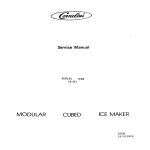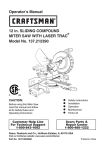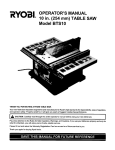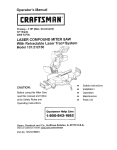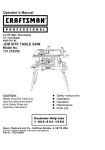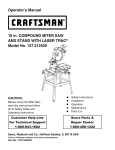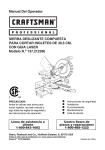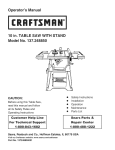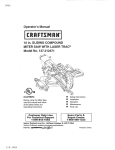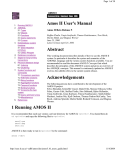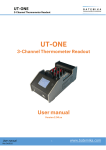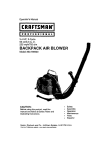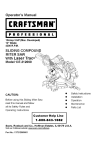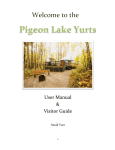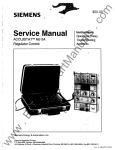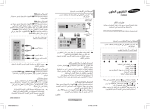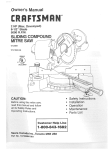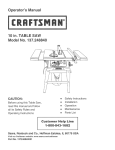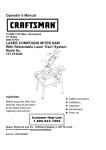Download Craftsman 137.21237 Saw User Manual
Transcript
Operator's Manual
CRSFrSMSN°
10 in. SLiDiNG COMPOUND
MITER SAW WiTH LASER TRAC ®
Model No. 137.212370
CAUTION:
Before using this Miter Saw,
read this manual and follow
all its Safety Rules and
Operating
instructions
Customer
Help
For Technical
Support
Visit our Craftsman
and Co., Hoffman
•
•
Operation
Maintenance
e
Parts List
Repair
Parts
Center
1-800-488-1222
Estates,
website: www.sears.condcraftsman
Part No. 137212370001
Safety Instructions
installation
Sears
Line
1-800-843-1682
Sears, Roebuck
•
•
IL 60179 USA
&
S ECTION
PAG E
SECTION
PAGE
Warranty ............................................................
2
Know Your Sliding Compound Miter Saw .....
Product Specifications ........................................
Power Tool Safety ..............................................
2
3
Glossary of Terms .........................................
Assembly ......................................................
9
10
Sliding Compound Miter Saw Safety ...................
Electrical Requirements and Safety ....................
Accessories and Attachments ............................
4
4
6
Adjustments ..................................................
Operat ion ......................................................
Maintenance .................................................
14
16
24
Tools Needed for Assembly ................................
Carton Contents ..................................................
6
7
Troubleshooting Guide .................................
Parts List .......................................................
25
26
ONE-YEAR
FULL WARRANTY
ON CRAFTSMAN
8
TOOL
If this Craftsman tool fails due to a defect in material or workmanship within one year from the date of purchase,
CALL 1-800-4-MY-HOME(_TO
ARRANGE FOR FREE REPAIR (or replacement if repair proves impossible).
If this tool is used for commercial or rental purposes, this warranty will apply for only ninety days from the date of
purchase. This warranty applies only while this tool is in the United States.
This warranty gives you specific legal rights, and you may also have other rights, which vary, from state to state.
Sears, Roebuck and Co., Hoffman
Estates, IL 60179
A WARNING
I
Some dust created by power sanding, sawing, grinding, drilling and other construction activities contains
chemicals known to cause cancer, birth defects or other reproductive harm. Some examples of these
chemicals are:
=
•
Lead from lead-based paints
Crystalline silica from bricks, cement and other masonry
products
•
Arsenic and chromium from chemically treated lumber
Your risk from these exposures varies, depending on how often you do this type of work. To reduce your
exposure to these chemicals,
dust masks that are specially
work in a well ventilated area and work with approved safety equipment such as
designed to filter out microscopic
particles.
MOTOR
Power Source ..........................
Arbor Shaft Size ....................
Speed ......................................
Brake .......................................
Double Insulated .....................
MITER SAW
Rotating Table:
Miter Detent Stops ...................
Bevel Positive Stops ................
Extension Wings ......................
MITER SAW
120',/AC, 60Hz, 15 Amp
5/8 in.
4800 RPM (No load)
Electric
Yes
0o,15°, 22.5°, 31.6°, 45° R & L
0 °, 33.9 °, 45 ° L
Yes
Cutting Capacity:
Crosscut ...................................
Miter 45 ° R. & L ........................
Bevel 45 ° L ...............................
45 ° Miter and 45 ° Bevel ............
BLADE
Diameter ...................................
Arbor .......................................
3-&/8
3-5/8
1-&/8
1-5/8
in. x
in. x
in. x
in. x
12 in.
8 in.
12 in.
8 in.
10 in.
5/8 in.
[A WARNING
I
To avoid electrical hazards, fire hazards or damage to the tool, use proper circuit protection.
This tool is wired at the factory for 110=120 Volt operation. It must be connected to a 110-120 Volt / 15 Ampere
time delay fuse or circuit breaker. To avoid shock or fire, replace power cord immediately if it is worn, cut or
damaged in any way.
Before using your tool, it is critical that you read and understand these safety rules. Failure to follow these
rules could result in serious injury to you or damage to the tool.
GENERAL
SAFETY
safety glasses. NOTE: Glasses or goggles not in
compliance with ANSI Z87.1 could cause serious
injury.
iNSTRUCTiONS
Read and understand all the instructions below
before using the power tool. These safety
instructions are not meant to cover every possible
condition that could occur. As with any power tool,
common sense, vigilance and due care must be
used.
I.
2.
3.
13. WEAR A FACE MASK OR DUST MASK, Sawing
operation produces dust.
14. SECURE WORK. Use clamps or a vise to hold work
when practical. It's safer than using your hand, and
it frees both hands to operate the tool.
READ and become familiar with the entire
Operator's Manual. LEARN the tool's applicationl
limitations and possible hazards.
15. DISCONNECT TOOLS FROM POWER SOURCE
before servicing and when changing accessories,
such as blades, bits and cutters.
KEEP GUARDS IN PLACE and in working order.
16. REDUCE THE RISK OF UNINTENTIONAL
STARTING. Make sure switch is in the OFF position
before plugging in the tool.
REMOVE ADJUSTING KEYS AND WRENCHES.
Form the habit of checking to see that keys and
adjusting wrenches are removed from the tool
before turning ON.
KEEP WORK AREA CLEAN, Cluttered areas and
benches invite accidents.
17. USE RECOMMENDED ACCESSORIES. Consult
this Operator's Manual for recommended
accessories. The use of improper accessories may
cause injury to yourself or others.
5.
DO NOT USE iN DANGEROUS ENVIRONMENTS.
Do not use power tools in damp locations or expose
them to rain or snow. Keep work area well lit.
18. NEVER STAND ON THE TOOL. Serious injury.
could occur if the tool is tipped or if the cutting tool
is unintentionally contacted.
6.
KEEP CHILDREN AWAY. All visitors and bystanders
should be kept at a safe distance from work area.
7.
MAKE WORKSHOP CHILDPROOF with padlocks;
master switches or by removing starter keys.
19. CHECK FOR DAMAGED PARTS. Check for
alignment of moving parts, binding of moving
parts, breakage of parts, mounting and any other
conditions that may affect its operation. A guard
or other part that is damaged should be properly
repaired or replaced.
8.
DO NOT FORCE THE TOOL. It will do the job
better and is safer if used at the rate for which it was
designed.
9.
USE THE RIGHT TOOL. Do not force the tool or an
attachment to do a job for which it was not designed.
4,
20. NEVER LEAVE THE TOOL RUNNING
UNATTENDED. TURN THE POWER OFF. Do not
walk away from a running tool until the blade comes
to a complete stop, and then unplug the unit.
21. DO NOT OVERREACH,
balance at all times.
I 0. USE PROPER EXTENSION CORDS. Make sure
your extension cord is in good condition. When
using an extension cord, be sure to use one heavy
enough to carP;/the current your product will draw.
An undersized cord will result in a drop in line
voltage and in loss of power that will cause the tool
to overheaL The table on page 5 shows the correct
size to use depending on cord length and nameplate
ampere rating. If in doubt, use the next heavier
gauge. The smaller the gauge number, the heavier
the cord.
Keep proper footing and
22. MAINTAIN TOOLS WITH CARE, Keep tools
sharp and clean for best and safest performance.
Follow instructions for lubricating and changing
accessories.
23. DIRECTION OF FEED. Feed work into a blade or
cutter against the direction or rotation of the blade or
cutter.
24. WARNING: Dust generated from certain materials
can be hazardous to your health. Always operate
the saw in a well-ventilated area and provide for
proper dust removal.
11. WEAR PROPER APPAREL. Do not wear loose
clothing, gloves, neckties, rings, bracelets or other
jewelry that may get caught in moving parts. Nonslip footwear is recommended. Wear protective hair
covering to contain long hair.
25. DO NOT loan your tool to another person without
providing him/her with the Operator's Manual.
Be sure he/she learns the tools applications and
possible hazards,
12. ALWAYS WEAR EYE PROTECTION. Any power
tool can throw debris into the eyes and could cause
permanent eye damage. ALWAYS wear Safety
Goggles (not glasses) that comply with ANSI Safety
standard Z87.1. Everyday eyeglasses
have only impact-resistant lenses. They ARE NOT
3
I. IMPORTANT:
DO
NOT USE THIN KERF BLADES.
They can deflect and contact the blade guard and
cause possible in]ury to the operator.
I9. iMPORTANT: ,After completing a cut, release the
trigger switch and wait for the blade to stop before
returning the saw to the raised position.
2.
DO NOT operate the miter saw until it is completely
assembled and installed according to these
instructions.
20. MAKE SURE the blade has come to a complete
stop before removing or securing the workpiece,
changing the workpiece angle or changing the angle
of the blade.
3.
IF YOU ARE NOT thoroughly familiar with the
operation of miter saws, seek guidance from your
supervisor, instructor or other qualified person.
4.
5.
6.
21. NEVER cut metals or masonry products with this
tool. This miter saw is designed for use on wood
and wood=like products.
ALWAYS hold the work firmly against the fence and
table. DO NOT perform any operation freehand (use
clamp wherever possible).
22. NEVER cut small pieces. If the workpiece being cut
would cause your hand or fingers to be within 7-1/2
in. of the saw blade, the workpiece is too small.
KEEP HANDS out of the path of the saw blade. If
the workpiece you are cutting would cause your
hands to be within 7-1/2 in. of the saw blade, the
workpiece should be clamped in place before
making the cut.
23. PROVIDE adequate support to the sides of the saw
table for long workpieces.
24. NEVER use the miter saw in areas with flammable
liquids or gases.
MAKE SURE the blade is sharp, runs freely and is
free of vibration.
7.
ALLOW the motor to come up to full speed before
starting a out.
8.
KEEP THE MOTOR AIR SLOTS CLEAN and free
of chips or dust.
9.
ALWAYS MAKE SURE all handles are tight before
cutting, even if the table is positioned in one of the
positive stops.
25. NEVER use solvents to clean plastic parts. Solvents
could possibly dissolve or otherwise damage the
material.
26. SHUT OFF the power before servicing or adjusting
the tool.
27. DISCONNECT the saw from the power source and
clean the machine when finished using.
28. MAKE SURE the work area is clean before leaving
the machine.
I 0. MAKE SURE both the blade and the collar are clean
and the arbor bolt is tightened securely=
29. SHOULD any part of your miter sat,, become
missing, damaged, fail in any way or any electrical
component fail to perform properly, shut off the
switch and remove the plug from the power supply
outlet. Replace missing, damaged or failed parts
before resuming operation.
11. USE only blade collars specified for your saw.
12. NEVER use blades larger than I 0 in. in diameter.
13. NEVER apply lubricants to the blade when the saw
is running.
[,_
14. ALWAYS check the blade for cracks or damage
before operation. Replace a cracked or damaged
blade immediately.
WARNING
J
POWER SUPPLY AND MOTOR SPECIFICATIONS
The AC motor used in this saw is a universal,
nonreversible type. See "MOTOR" in the "PRODUCT
SPECIFICATIONS" section on page 2.
15. NEVER use blades recommended for operation at
less than 4800 rpm
To avoid electrical hazards, fire hazards or damage to
the tool, use proper circuit protection. Your saw is wired
at the factory for 120 V operation. Connect to a 120 V
circuit. This circuit must not be less than a #I 2 wire with
a 20 A time-lag fuse or a #14 wire with a 15 A time-lag
fuse. To avoid shock or fire, if power cord is worn or cut,
or damaged in any way, have it replaced immediately.
16. ALWAYS keep the blade guards in place and use at
all times.
! 7. NEVER reach around the saw blade=
18. MAKE SURE the blade is not in contact with the
workpiece before the switch is turned ON.
4
ELECTRICAL
REQUIREMENTS
4. FUSES may "blow" or circuit breakers may trip
- cont'd
DOUBLE INSULATED []
The power tool is double insulated to provide a double
thickness of insulation between you and tool's electrical
system. All exposed metal parts are isolated from
the internal metal motor components with protecting
insulation:
frequently if:
a. MOTOR is overloaded - overloading can occur if
you feed too rapidly or make too many start/stops
in a short time.
b. LINE VOLTAGE is more than 10% above or
below the nameplate voltage rating. For heavy
loads, the voltage at motor terminals must equal
the voltage specified on the nameplate.
c. IMPROPER or dull saw blades are used.
5. Most motor troubles may be traced to loose or
incorrect connections, overload, low voltage or
inadequate power supply wiring. Always check the
connections, the load and supply circuit if the motor
doesn't run well. Check minimum gauge for the
length of cord you are using on the chart below.
Replacement parts - When servicing use only identical
replacement parts.
Polarized plugs = This saw has a plug that looks like
the one shown below:
GUIDELINES
FOR EXTENSION
CORDS
Use a proper extension cord Make sure your
extension cord is in good condition. When using an
extension cord, be sure to use one hea W enough to
carp/the current your product will draw. An undersized
cord will cause a drop in line voltage, resulting in loss of
power and cause overheating. The table below shows
the correct size to use depending on cord length and
nameplate ampere rating. If in doubt, use the next
heavier gauge. The smaller the gauge number, the
heavier the cord.
To reduce the risk of electrical shock, this saw has a
polarized plug (one blade is wider than the other). This
plug will fit in a polarized outlet only one way. If the plug
does not fit fully in the outlet, reverse the plug. If it still
does not fit, contact a qualified electrician to install the
proper outlet. Do not change the plug in any way.
[A WARNING
I
Be sure your extension cord is properly wired and
in good condition. Always replace a damaged extension
cord or have it repaired by a qualified person before
using it. Protect your extension cords from sharp
objects, excessive heat and damp or wet areas.
Double insulation does not take the place of normal
safety precautions when operating this tool.
To avoid electrocution:
1. Use only identical replacement parts when
servicing a tool with double insulation. Servicing
should be performed by a qualified technician.
Use a separate electrical circuit for your tools. This
circuit must not be less than a #I 2 wire with a 20 A
time-lag fuse or a #14 wire with a 15 A time-lag fuse.
NOTE: When using an extension cord on a circuit with
a # 14 wire, the extension cord must not exceed 25 feet
in length. Before connecting the tool to the power line,
make sure the switch is in the OFF position and the
electric current is rated the same as the current stamped
on the motor nameplate, running at a lower voltage will
damage the motor.
2. Do not use power tools in wet or damp locations
or expose them to rain or snow.
MOTOR
SAFETY
PROTECTION
IMPORTANT:
To avoid motor damage, the motor should be blown out
or vacuumed frequently to keep sawdust from interfering
with the motor ventilation.
1. CONNECT this saw to a 120 V, 15 A circuit with a 15
A time-delay fuse or circdt breaker. Using the wrong
size fuse can damage the motor.
2. If the motor won't start, release the trigger switch
immediately. UNPLUG THE SAW. Check the saw
•
_
=
e =
=
Q
O=lJ
=
(When usng 120 volts only)
Ampere
MoreThan
0
6
10
blade to make sure it turns freely. If the blade is free,
try to start the saw again. If the motor still does not
start, refer to the TROUBLESHOOTING GUIDE.
3. If the tool suddenly stalls while cutting wood, release
the trigger switch, unplug the tool, and free the blade
from the wood. The saw may now be started and the
cut finished.
Rating
Total
Not MoreThan 25ft.
6
18
10
18
12
16
of Cord
100ft. 150ft.
16
14
14
12
14
12
length
50ft.
16
16
16
CAUTION: In all cases make certain the receptacle in
question is properly grounded. If you are not sure,
have a certified
5
electrician
check the receptacle.
RECOMMENDED
ACCESSORIES
Supplied
Not supplied
....................
[AWARNING[
•
Use only accessories recommended for this
miter saw. Follow instructions that accompany
accessories. Use of improper accessories
cause hazards.
•
Blade Wrench
Adjustable Wrench
may
Hex Key
The use of any cutting tool except 10 inch saw
blades which meet the requirements under
recommended accessories is prohibited. Do
not use accessories such as shaper cutters or
dado sets. Ferrous metal cutting and the use of
Combination Square
abrasive wheels is prohibited.
= Do not attempt to modify this tool or create
accessories not recommended for use with
Phillips Screwdriver
this tool. Any such alteration or modification is
misuse and could result in a hazardous condition
leading to possible serious injury.
Slotted Screwdriver
ACCESSORIES
Visit your Sears Hardware Department or see the
COMBINATION
Sears Power and Hand Tool Catalog to purchase
recommended accessories for this power tool.
[_IL WARNING
MUST BE TRUE
Should not gap or overlap when square is flipped over
(see dotted figure).
Straight edge or
a 3,/4 in. board,
this edge must be
Draw light line on board
perfectly straight.
along this edge.
I
To avoid the risk of personal injury, do not modify this
power tool or use accessories not recommended by
Sears.
[_IL WARNING
SQUARE
r_
I
Read warnings and conditions on your CARBIDE TIPPED
SAW BLADE. Do not operate the saw without the proper
saw blade guard in place. Carbide is a very hard but
brittle material Care should be taken while mounting,
using and storing carbide tipped blades to prevent
accidental damage. Slight shocks, such as striking the
tip while handling, can seriously damage the blade.
Foreign objects in the workpiece, such as wire or nails,
can also cause tips to crack or break off. Before using,
always visually examine the blade and tips for bent
blade, cracks, breakage, missing or loose tips, or other
damage. Do not use if damage is suspected. Failure
to heed safety instructions and warnings can result in
serious bodily injury.
t
f
I
t
Gap from untrue square
when flipped over.
6
UNPACKING
YOUR
MITER SAW
,
Place the saw on a secure stationary work surface.
3. Separate all parts from the packing material. Check
each one with the illustration below to make certain
[A WARNING
[
To avoid injury from unexpected starting or
electrical shock, do not plug the power cord into a
source of power during unpacking and assembly.
The cord must remain unplugged whenever you are
adjusting/assembling
the saw.
packing material.
IA WARNING
[
If any part is missing or damaged, do not attempt
to assemble the miter saw, or plug in the power
cord until the missing or damaged part is correctly
replaced. To avoid electric shock, use only identical
I. Remove the miter saw from the carton.
IMPORTANT:
all items are accounted for before discarding any
Do not lift the miter saw by the
switch handle or miter table handle. It may cause
misalignment. Lift only by the built-in carrying handles
located at the top of the machine.
replacement parts when servicing double insulated
tools. Call 1-800-4-MY-HOME e for replacement parts.
Miter Saw
Blade Wrench
Dust Bag
Hold-Down Clamp
Miter Handle
UpperBladeGuard
CarryingHandle
LaserGuide
CarryingHandle
LaserON/OFFswitch
SwitchHandle
BevelDetentPin
Hold-Down
Clamp,..,,
ON/OFFTriggerSwitch
Fence
LowerBladeGuard
Mounting
Holes
Blade
Table
Base
LeftExtension
Table
SlideCarriage
CarryingHandle
SlideCarriageLockKnob
RightExtensionTable
Motor
StopPlate
TableInsert
PositiveStopLockingLever
PositiveMiterDetents
8
ARBOR LOCK - Allows the user to keep the blade from
WRENCH STORAGE - Convenient storage to prevent
misplacing the blade wrench.
rotating while tightening or loosening the arbor locking
bolt during blade replacement or removal.
WOODWORKING
BASE - Supports the table, holds accessories and
allows for workbench or leg set mounting.
TERMS
ARBOR - The shaft on which a blade is mounted.
BEVEL LOCKING HANDLE - Locks the miter saw at a
desired bevel angle.
BEVEL CUT -An
the workpiece.
angle cut made through the face of
BEVEL SCALE - To measure the bevel angle of the
saw blade 0 ° to 45 ° left.
COMPOUND CUT - A simultaneous bevel and miter cut.
COVER PLATE SCREW - Loosen this screw and rotate
CROSSCUT - A cut made across the width or grain of
the workpiece.
the plate for access to the blade arbor locking bolt.
FREEHANDPerforming a out without using a fence
(guide), hold down or other proper device to prevent the
FENCE - Helps to keep the workpiece from moving
when sawing. Scaled to assist with accurate cutting.
workpiece from twisting during the cutting operation.
LOWER BLADE GUARD - Helps protect your hands
from the blade in the raised position. It retracts as the
blade is lowered
GUM -A sticky sap from wood products.
MITER HANDLE - Used to rotate the saw to the right or
left cutting position.
KERF - The amount of material removed by blade cut.
HEEL - Misalignment of the blade.
MITER CUT - An angle cut made across the width or
MITER SCALE - To measure the miter angle 0 ° to 45 °
left, 0 ° to 45 ° right.
grain of the workpiece.
RESIN - A sticky sap that has hardened.
MOUNTING HOLES - Used to mount the miter saw to a
stable surface=
REVOLUTIONS PER MINUTE (RPM) - The number of
turns completed by a spinning object in one minute.
ON/OFF TRIGGER SWITCH -To start the tool, squeeze
the trigger. Release the trigger to stop the miter saw.
SAW BLADE PATH - The area of the workpiece or
table top directly in line with the travel of the blade or the
part of the workpiece that will be cut.
POSITIVE STOP LOCKING LEVER - Used in
combination with the miter handle, it Pocksthe miter saw
at a preset positive stop for the desired miter angle.
SET - The distance between two saw blade tips, bent
outward in opposite directions to each other. The farther
apart the tips are, the greater the set.
STOP LATCH - Locks the miter saw in the lowered
position for compact storage and transportation.
WORKPIECE
SWITCH HANDLE - The switch handle contains the
- The item being cut. The surfaces of a
workpiece are commonly referred to as faces, ends and
edges.
trigger switch. The blade is lowered into the workpiece
by pushing down on the handle. The saw will return to
its upright position when the handle is released.
WARNING LABELS - Read and understand for your
own safety. Always make certain these are in place and
legible.
9
CUTTING HEAD (FIG. C)
Raising
1. Push down slightly on the switch handle (I).
2. Pull out the stop latch knob (2).
3. Allow the cutting head to rise to the up position.
Estimated Assembly Time: 5 - 10 minutes
[,AWAR"I"G
I
To avoid injury, do not connect this miter saw to the
power source until it is completely assembled and
adjusted and you have read and understood this
Operator's Manual.
IA WARNING
I
iNSTALLiNG THE MITER HANDLE (FIG. A)
1 Thread the miter handle (1) into the hole located at
the front of the miter table.
To avoid injury and damage to the saw, transport
and store the miter saw with the cutting head locked
in the down position. Never use the stop latch to
hold the cutting head in a down position for cutting
operations.
Fig. A
Fig, C
UNLOCKING THE SLIDE CARRIAGE (FIG. B)
After removing the saw from the carton, loosen the slide
carriage lock knob (1). When transporting or storing the
miter saw, the slide carriage should always be locked in
position. The slide carriage lock knob (1) is located on
the bottom of the slide carriage.
Locking
When transporting or storing the miter saw, the cutting
head should always be locked in the down position.
1. Push the cutting head down to its lowest position.
2. Push the stop latch knob (2) into the locking hole.
IMPORTANT: To avoid damage, never carry the miter
saw by the switch handle, the cutting arm or the miter
handle. ALWAYS use the designated carrying handle.
Fig. B
iNSTALLiNG THE DUST BAG (FIG. D)
1. Squeeze the metal collar wings (2) of the dust bag (1).
2. Place the dust bag neck opening around the exhaust
port (3), and release the metal collar wings.
SAW BLADE WRENCH (FIG. B-l)
1. For convenient storage and prevention of loss, there
is a slot (1) in the rear of the carrying handle (2) for
storing the blade wrench (3) when not in use.
Fig. B-1
3
I
Fig. D
I
2
10
2
iNSTALLiNG THE HOLD-DOWN
CLAMP
1. To remove, loosen and remove the six screws (1)
(FIG. E and E-l)
I. Place the hold=down clamp assembly (1) in one of
the mounting holes (2).
on the table insert (2) with a Phillips screwdriver and
remove the insert.
2. To install, reposition the table insert, install the six
NOTE: There are no screws to secure clamp. The
clamp will secure itself to the base when turning the
knob (3) to clamp the workpiece. Do not use your
other hand to hold the clamp when tightening. Only
screws and tighten.
3. Check for blade clearance by moving the slide
carriage through the full motion of the blade in the
table slot.
turn knob (3) to secure clamp to table. The clamp will
tilt at an angle and secure itself when tightened_
Fig. F
[A WARNING
I
I
When using stop block on the right side, hold-down
clamp must also be in right side. Using hold-down
clamp on the Deftside during this operation can
I
i
i
i
cause kickback and serious injury to the operator.
!
Fig. E
MOUNTING THE MITER SAW (FIG. G, G=I)
IAWARNmNG
I
To avoid injury form unexpected saw movement:
= Disconnect the power cord from the outlet, and
lock the cutting head in the lower position using
the stop latch.
Fig. E-1
2
J_
\_._/2
e
Lock the slide carriage in place by tightening the
slide carriage lock knob.
= To avoid back injury, lift the saw by using the
designated carrying handles located on the top
of the machine. When lifting, bend at your knees,
2
•
REMOVING AND iNSTALLiNG THE TABLE INSERT
power cord could cause damage to the insulation
or the wire connections resulting in electric
shock or fire.
(FIG. F)
[A wARNINe
!
= To avoid injury from flying debris, do not allow
visitors to stand near the saw during any cutting
To avoid injury:
,= Always unplug the saw to avoid accidental starting.
Remove all small pieces of material from the table
operation.
= Support the saw on a level work surface.
= Bolt or clamp the saw to its support.
cavity before performing any cuts. The table insert
may be removed for this purpose, but always
•
not from your back.
Never carry the miter saw by the power cord or
by the switch handle. Carrying the tool by the
reattach the table insert prior to performing a cutting
operation.
Do not start the sliding compound miter saw without
checking for interference between the blade and
table insert. Damage could result to the blade, table
insert or turntable if blade strike occurs during the
cutting operation.
11
Mountinginstructions
4. Rotate the cover plate (3) towards the rear of the tool
1. For stationary use, place the saw in the desired
to expose the arbor bolt (4).
5. Place the blade wrench over the arbor bolt.
location, directly on a workbench where there is room
for handling and proper support of the workpiece.
The base of the saw has four mounting holes. Bolt
the base of the miter saw (1) to the work surface (5),
Fig.H
3
using the fastening method as shown in Fig G.
2
Fig. G
4
2.
1. Hex
Miter head
saw bolt
base
3. Rubber washer
3
2
4
4. Flat washer
5. Workbench
1
6. Flat washer
7. Lockwasher
//
,,
_
_
I
I 1
5
Locate the arbor lock (5) on the motor, below the
switch handle. (Fig. I)
7. Press the arbor lock, holding it in firmly while turning
the blade wrench clockwise. The arbor lock will
.
_
8
9. Jam nut
8. Hex nut
_
9
engage after turning the wrench. Continue to hold the
arbor locking to keep it engaged, while turning the
wrench clockwise to loosen the arbor bolt.
NOTE: Mounting hardware is not included with this tool.
Bolts, nuts, washers and screws must be purchased
separately.
2. For portable use, place the saw on a 3/4 in. thick
piece of plywood. Bolt the base of the miter saw
Fig.I
securely to the plywood using the mounting holes
on the base. Use C-clamps to clamp this mounting
board to a stable work surface at the worksite.
5
(Fig. G-1 )
Fig.G-1
8. Remove the arbor bolt (6), the outer blade collar (8)
and the blade (7). Do not remove the inner blade
coltar. (Fig. J)
NOTE: Pay attention to the pieces removed, noting their
position and direction they face. Wipe the blade collars
clean of any sawdust before installing a new blade.
REMOVING AND INSTALLING
THE BLADE
Fig. J
WARNING]
Do not use a blade larger than 10 in. in diameter.
To avoid injury from an accidental start, make sure
the switch is in the OFF position and the plug is not
connected to the power source outmet.
Removing Blade (Fig. H, I and J)
1. Unplug the saw from the outlet.
8
2. Allow the cutting head to rise to the upright position.
Raise the lower blade guard (1) to the up position.
3. Loosen the cover plate screw (2) with a Phillips
screwdriver.
12
7
Installing Blade (Fig. H, I, J)
Unplug the miter saw before changing/installing the
blade.
I. Install a I 0 in. blade with a 5/8 in. arbor, making
sure the rotation arrow on the blade matches the
1 .To turn laser on, press on/off rocker switch (1) to
"ON" position:
2.To turn off laser, press on/off rocker switch (1) to
"OFF" position.
clockwise rotation arrow on the upper guard and the
blade teeth are pointing downward.
2. Place the outer blade collar (8) against the blade and
on the arbor. Thread the arbor bolt (6) onto the arbor
(Fig. J) in a counterclockwise direction.
IMPORTANT: Make sure the flats of the blade collars
Fig. K
are engaged with the flats on the arbor shaft.
3. Place the blade wrench on the arbor bolt.
4. Press the arbor lock (5), holding it in firmly while
turning the blade counterclockwise. When arbor lock
engages, continue to press it in while tightening the
arbor bolt securely.
5. Rotate the cover plate (3) back to its original position
until the slot in the cover plate engages with the cover
plate screw (2). While holding the lower blade guard,
tighten the screw with a Phillips screwdriver. (Fig. H)
NOTE: The lower blade guard must be raised to the
upright position to access the cover plate screw.
6. Lower the blade guard (1) and verify that the
operation of the guard does not bind or stick. (Fig. H)
7. Be sure the arbor lock is released so the blade turns
Your tool is equipped with the Laser Trad _ cutting
guide using Class II laser beam. The laser beam will
enable to preview the saw blade path on the stock to
be cut before starting the miter saw. This laser guide is
powered by the transformed alternating current supply
directly through the power lead. The saw must be
connected to the power source and the laser on/off
switch must be turned on for the laser line to show.
freely.
[A WARNING
]
[A wARN.'JG
I
• AVOID DIRECT EYE CONTACT
• To avoid injury, never use the saw without the
cover plate secure in place. It keeps the arbor
bolt from falling out if it accidentally loosens, and
helps prevent the spinning blade from coming off
the saw.
• Make sure the collars are clean and properly
arranged. Lower the blade into the lower table
and check for any contact with the base or the
miter table by spinning the blade manually.
Laser radiated when laser guide is turned on.
Avoid direct eye contact.
• Laser Warning Label: Max output <lmW DIODE
LASER: 630-670nm, Complies with 21CFR 1040.10
and 1040. 11.
• CAUTION-Use of controls or adjustments or
performance of procedures other than those
specified herein may result in hazardous
radiation exposure.
® CAUTiON-The use of optical instruments with
this product will increase eye hazard.
= Do not attempt to repair or disassemble
the
laser. If unqualified persons attempt to repair
this laser product, serious injury may result.
Any repair required on this laser product
should be performed by authorized service
center personnel.
[A WAR.ING
I
For your own safety, never connect the plug to
power source outlet until all the adjustment steps
are complete and you have read and understood the
safety and operational instructions.
THE LASER GUIDE (FIG. K)
[A WARNING
I
Make the ON/OFF switch childproof. Insert a
padlock, or chain with padlock, through the holes
(2) in the trigger switch, locking the tool's switch,
preventing children and other unqualified users
from turning the machine on.
13
BEVEL STOP ADJUSTMENT
Fig. M
y
[4 WARNNNG
I
To avoid injury from an accidental start, make sure
5
the switch is in the OFF position and the plug is not
connected to the power source outlet.
6
90 ° (0 °) Bevel adjustment
(Fig. L)
I. Loosen bevel lock handle (1) and tilt the cutting arm
completely to the right. Tighten the bevel lock handle.
2. Place a combination square (2) on the miter table
45 ° Bevel Adjustment (Fig. N)
1. Loosen the bevel lock handle (7) and tilt the cutting
head completely to the left.
with the ruler against the table and the heel of the
square against the saw blade.
3. If the blade is not 90 ° (0°) square with the miter
table (5), loosen the bevel lock handle (I), tilt the
2. Using a combination square, check to see if the
blade angle is 45 ° to the table.
3. If the blade is not at 45 ° to the miter table, tilt the
cutting arm to the right, loosen the Iocknut (8) on the
cutting head to the left, loosen the Iocknut (4) on the
bevel angle adjustment bolt (3) and use a 10 mm
bevel angle adjustment bolt (9) and use a 10 mm
wrench to adjust the stop bolt (9) depth in or out to
increase or decrease the bevel angle.
wrench to adjust the stop bolt (3) depth in or out to
increase or decrease the bevel angle.
4 Tilt the cutting arm to back to the right at 90 _'(0°)
bevel and recheck for alignment.
4. Tilt the cutting arm to the left to 45 ° bevel and
recheck for align ment.
5. Repeat steps 1 through 4 until the blade is at 45 ° to
the miter table.
5. Repeat steps 1 through 4 if further adjustment is
needed.
6. Tighten bevel lock handle (7) and Iocknut (8) when
6 Tighten bevel lock handle (1) and Iocknut (4) when
alignment is achieved.
alignment is achieved
Fig. N
Fig. L
10
i
7
9_---- i
J
12
8
11
1
5
2
33.9 ° Bevel Adjustment (Fig. N)
1. Push the bevel detent pin (10) in toward the front of
the unit.
2. Unlock the bevel lock handle and tilt the cutting arm
to the crown molding positive stop at 33.9 °
3. Using a combination square, check to see if the
blade angle is 33.90 to the table.
4. If the blade is not at 33.90 to the miter table, loosen
90 ° Bevel Pointer Adjustment (Fig. M)
1. When the blade is exactly 90 °`(0°) to the table, loosen
the bevel indicator screw (5) using a # 2 Phillips
screwdriver.
Iocknut (11 ) and use a 10 mm wrench to adjust the
bolt (12) in or out until the blade is at 33.9 ° to the
miter table.
2. Adjust bevel indicator (6) to the "0" mark on the bevel
scale and retighten the screw.
5. Secure the Iocknut (11 ) into position after alignment
is achieved.
14
MITER ANGLE ADJUSTMENT (FIG. O)
The sliding compound miter saw scale can be easily
read, showing miter angles from 0 ° to 45 ° to the left,
Fig. P
1
and 0 _'to 45 ° to the right. The miter saw table has nine
of the most common angle setttings with positive stops
at 0 _',15 °, 22.5 °, 31.6 °, and 45 °. These positive stops
position the blade at the desired angle quickly and
accurately. Follow the process below for quickest and
most accurate adjustments.
I. Unlock the miter table by turning the miter handle (1)
counterclockwise.
2. Move the turntable while lifting up on the positive
stop locking lever (2) to align the indicator (3) to the
desired degree measurement.
3. If the desired angle is one of the nine positive stops,
release the positive stop locking lever; making sure
SETTING CUTTING DEPTH (FIG. Q)
The depth of cut can be preset for even and repetitive
shallow cuts.
the lever snaps into position, and then secure by
tightening the miter handle.
1. Adjust the cutting head down (See CUTTING HEAD
section) until the teeth of the blade are at the desired
depth.
4. If the miter angle desired is not one of the nine
positive stops, simply lock the miter table into position
by turning the miter handle in the clockwise direction.
2. While holding the upper arm in that position, turn the
stop knob (1) until it touches the stop plate (2).
3. Recheck the blade depth by moving the cutting head
Fig. 0
front to back through the full motion of a typical cut
along the control arm.
1
Fig. Q
2
MITER SCALE INDICATOR ADJUSTMENT (FIG. O)
I. Move the table to the 0 ° positive stop.
2. Loosen the screw (4) that holds the indicator with a
Phillips screwdriver.
3. Adjust the indicator (3) to the 0 ° mark and retighten
screw.
ADJUSTING CUTTING DEPTH (FIG. Q)
The maximum depth travel of the cutting head was set
at the factory. Check to see that the blade does not
extend more than 1/4 in. below the table insert, and
ADJUSTING FENCE SQUARENESS (FIG. P)
1. Loosen the four fence locking bolts (1).
2. Lower the cutting arm and lock in position.
does not touch the control arm throat or any part of the
base or table. If the maximum depth needs readjusting:
I. Loosen the stop knob (1) while moving the cutting
3. Using a square (3), lay the heel of the square against
the blade and the ruler against the fence (2) as
shown.
head down until the blade extends just 1/4 in. below
the table insert.
4. Adjust the fence 90 ° to the blade and tighten the four
fence locking bolts.
CAUTION: If the saw has not been used recently,
2. Adjust the stop knob (1) to touch the stop plate (2).
3. Recheck the blade depth by moving the cutting head
front to back through the full motion of a cut along
the control arm. If the blade touches the inside of the
recheck blade squareness to the fence and
readjust if needed.
5. After fence has been aligned, using a scrap piece of
wood, make a cut at 90 ° then check squareness on
the piece. Readjust if necessary.
control arm, readjust the setting.
15
SAFETY iNSTRUCTiONS
OPERATIONS
FOR BASIC SAW
•
BEFORE USING THE MITER SAW
[A WARNING
To avoid mistakes that could cause serious,
permanent injury, do not plug the tool in until the
following steps are completed:
•
Completely assemble and adjust the saw,
following the instructions. (SEE ASSEMBLY
ADJUSTMENTS SECTIONS)
•
•
•
•
Maintain tools with care. Keep the miter saw clean
for best and safest performance. Follow instructions
for lubricating. Do not apply lubricants to the blade
while it is spinning.
•
Remove all adjusting wrenches from the tool before
turning it on.
To avoid injury from jams, slips, or thrown pieces,
use only recommended accessories.
AND
o Learn the use and function of the ON/OFF switch,
upper and lower blade guards, stop latch, bevel lock
handle and cover plate screws.
missing, damaged or broken, or any electrical parts
do not work, turn off the saw and unplug it.
Replace bent, damaged, missing or defective parts
before using the saw again.
RECOMMENDED
•
Review and understand all safety instructions and
operating procedures in this Operator's Manual. (SEE
SAFETY AND OPERATIONS SECTIONS)
ACCESSORIES
Consult the ACCESSORIES and ATTACHMENTS
section of this Operator's Manual for recommended
accessories. Follow the instructions that come with
the accessory'. The use of improper accessories may
Reviewthe MAINTENANCE AND
TROUBLESHOOTING GUIDE for your miter saw.
•
To avoid injury or possible death from electrical
shock, make sure your fingers do not touch the
plug's metal prongs when plugging in or
unplugging your miter saw. (SEE ELECTRICAL
REQUIREMENTS AND SAFETY SECTIONS)
•
BEFORE EACH USE
cause risk of injury.
Choose the correct 10 in. blade for the material and
the type of cutting you plan to do. Do not use thin
Kerr blades.
Make sure the blade is sharp, undamaged and
properly aligned. With the saw unplugged, push the
cutting arm all the way down. Manually spin the blade
and check for clearance. Tilt the miter head to a 45 °
bevel and repeat the test.
Make sure the blade and arbor collars are clean.
Inspect your saw.
•
•
Disconnect the miter saw. To avoid injury from
accidental starting, unplug the saw before any
adjustments, including setup and blade changes.
•
•
Compare the direction of rotation arrow on the
guard to the direction arrow on the blade. The blade
teeth should always point downward at the front of
the saw.
KEEP YOUR WORK AREA CLEAN
Cluttered areas and benches invite accidents.
•
•
•
[,&WARNmNG
]
Tighten the arbor bolt.
Tighten the cover plate screw.
Check for damaged parts, check for:
o Alignment of moving parts
e Damaged blade teeth
• Damaged electric cords
o Binding of moving parts
e Mounting holes
• Function of arm return spring and lower guard:
Push the cutting arm all the way down, and
then let it rise until it stops. The lower guard
should close fully. Follow the instructions in the
TROUBLESHOOTING GUIDE for adjustment, if
necessary.
To avoid burns or other fire damage, never use the
miter saw near flammable
liquids, vapors or gases.
o Plan ahead to protect your eyes, hands, face and
ears.
=, Other conditions that may affect the way the miter
saw works.
•
Make sure all clamps and locks are tight and there is
no excessive play in any parts.
Keep all guards in place, in working order and
properly adjusted. If any part of this miter saw is
16
•
Know your miter saw.
Read and understand the Operator's Manual and
labels affixed to the tool. Learn its application and
limitations as well as the potential hazards specific
to this tool. To avoid injury from accidental contact
with moving parts, do not lay out, assemble or set up
work on the miter saw.
•
Avoid accidental starting. Make sure the switch is in
the OFF position before plugging the miter saw into a
power outlet.
PLAN YOUR WORK
•
Use the right tool. Do not force a tool or attachment
to do a job it was not designed to do. Use a different
tool for any workpiece that cannot be held in a solidly
braced, fixed position.
Keep the out piece free to move sideways after it is
cut off. Otherwise, it could get wedged against the
blade and thrown violently.
e Only the workpiece should be on the saw's table.
• Secure work. Use clamps or a vise to help hold the
work when it is practical.
[A WARNING
I
This machine is NOT designed for cutting masonry,
masonry products or ferrous metals (steel, iron
and iron-based metals.) Use this miter saw to cut
only wood and wood by-products. Other materials
may shatter, bind the blade or create other dangers.
Remove all nails that may be in the workpiece to
prevent sparking that could cause a fire.
USE EXTRA CAUTION WITH LARGE OR ODD
SHAPED WORKPIECES
DRESS FOR SAFETY
o Do not use this saw to cut small pieces. If the
workpieoe being cut would cause your hand or
fingers to be within 7-1/2 in. of the saw blade, the
workpiece is too small. Keep hands and fingers out of
the "no-hands zone" area marked on the saw's table.
•
o Never use another person as a substitute for a table
extension or as an additional support for a workpiece
that is longer or wider than the basic miter saw table,
or to help feed, support or pull the workpiece.
Any power tool can throw debris into the eyes. This can
result in permanent eye damage. Everyday eyeglasses
have only impact resistant lenses and are not safety
glasses. Glasses or goggles not in compliance with
ANSI Z87.! could seriously injure you when they break.
•
Do not wear loose clothing, gloves, neckties or
jewelry (rings, watches). They can get caught and
draw you into moving parts.
o
•
•
•
Wear non-slipfootwear.
Tie back long hair.
Roll long sleeves above the elbow.
Noise levels vary widely. To avoid possible hearing
damage, wear hearing protection when using any
miter saw.
•
o When cutting odd shaped workpieces, plan your work
so it will not bind in the blade and cause injury. Molding,
for example, must lie flat or be held by a fixture or jig
that will not let it move when cut.
• Properly support round material such as dowel rods
or tubing, which have a tendency to roll when cut,
causing the blade to "bite."
[,&WARNING
]
To avoid injury, follow all applicable safety
instructions when cutting non-ferrous metals:
• Use only saw blades specifically recommended for
non-ferrous metal cutting.
• Do not cut metal workpieces that must be hand held.
Clamp workpieces securely.
• Cut non-ferrous metals only if you are under the
supervision of an experienced person and the dust
bag has been removed from the saw.
For dusty operations, wear a dust mask along with
safety goggles.
iNSPECT YOUR WORKPIECE
•
Make sure there are no nails or foreign objects in the
part of the workpiece being cut.
•
Plan your work to avoid small pieces that may bind or
are too small to clamp and hold securely.
•
Plan the way you will grasp the workpiece from
start to finish. Avoid awkward operations and hand
positions. A sudden slip could cause your fingers or
hand to move into the blade.
WHEN SAW IS RUNNING
IA WARNING
I
DO NOT OVERREACH
Do not allow familiarity from frequent use of your
miter saw to result in a careless mistake. A careless
fraction of a second is enough to cause a severe
injury.
Keep good footing and balance. Keep your face and
body to one side, out of the line of a possible kickback.
NEVER stand in the line of the blade.
Never cut freehand:
•
Brace your workpiece firmly against the fence and
table stop so it will not rock or twist during the cut.
•
Make sure there is no debris between the workpiece
and the table or fence.
•
Make sure there are no gaps between the workpiece,
fence and table that will let the workpiece shift after it
is cut.
Use extra supports (tables, sawhorses, blocks, etc.)
for workpieces large enough to tip.
Before cutting, if the saw makes an unfamiliar noise
or vibrates, stop immediately. Turn the saw OFF.
Unplug the saw. Do not restart until you find and
correct the problem.
17
BODY AND HAND POSITION (FIG. R)
BASIC SAW OPERATIONS
(A WARNINO
[
[AWARNING
J
Never place hands near the cutting area. Proper
positioning of your body and hands when
operating the miter saw will make cutting easier and
safer. Keep children away. Keep aH visitors at a safe
distance from the miter saw. Make sure bystanders
are clear of the saw and workpiece. Don't force the
saw. It will do the job better and safer at its designed
rate.
For your convenience, your saw has a blade brake.
The brake is not a safety device. Never rely on it to
replace the proper use of the guard on your saw.
If the blade doesn't stop within approximately 6
seconds, wait for the blade to stop, unplug the saw
and contact customer service.
TO TURN SAW ON (FIG. S)
Squeeze the trigger switch (I) to turn the miter saw ON.
Release the trigger switch to turn the saw OFF.
Starting a cut:
o Place hands at least 7=1/2 in. away from the path
of the blade - out of the "no-hands zone" (1).
• Hold workpiece firmly against the fence to prevent
movement toward the blade.
NOTE: Make the ON/OFF switch chiidproof. Insert a
padlock, or chain with padlock, through the holes (2) in
the trigger switch, locking the tool's switch, preventing
children and other unqualified users from turning the
machine on.
•
With the power switch OFF, bring the saw blade
down to the workpiece to see the cutting path of
the blade.
= Squeeze trigger switch to start saw.
• Lower blade into workpiece with a firm downward
motion.
The miter saw is equipped with an automatic blade
brake. When the trigger switch is released, the electric
blade brake will stop the blade within approximately 6
seconds.
Finishing a cut:
o Hold the cutting arm in the down position.
o Release trigger switch and wait for all moving
parts to stop before moving your hands and
raising the cutting arm
o If the blade doesn't stop within 6 seconds,
unplug the saw and follow the instructions
in TROUBLESHOOTING GUIDE section for
(A WARNING
[
To avoid injury, after completing a cut and releasing
the trigger switch, allow the blade brake to activate
and stop the blade before raising the cutting head.
IAWARNmNO
I
To avoid injury, check and tighten the arbor bolt
periodically.
adjusting the blade brake before using the saw
again.
Fig. S
Before freeing jammed material:
6 Release trigger switch.
o Wait for all moving parts to stop.
• Unplug the miter saw.
Fig. R
•
#
7-I/2 in_'''°
l
7-1/2 in.
18
I
SLIDING CARRIAGE SYSTEM (FIG. 1")
When the table is in the desired position, as shown
on the miter scale (3), release the positive stop
[A WARNING
I
locking lever and tighten the miter handle. The table
is now locked at the desired angle. Positive stops are
provided at 0 °, 15°, 225 °, 31.6 ° and 45 °.
To reduce the risk of injury, return carriage to the
full rear position after each crosscut operation.
IMPORTANT: Always tighten the miter table lock
handle before performing every cutting operation.
I. For chop cutting operations on small workpieces,
slide the cutting head assembly completely toward
the rear of the unit and tighten the carriage lock
knob (1).
Fig. U
2. To cut wide boards up to 12 in., the carriage lock
knob must be loosened to allow the cutting head to
slide freely.
Fig. T
BEFORE LEAVING THE SAW
BEVEL CUT (FIG. V)
1. When a bevel cut is required, loosen the bevel lock
handle (1) by turning it clockwise.
2. Tilt the cutting head to the desired angle, as shown
on the bevel scale (2).
3. The blade can be positioned at any angle, from a
90 ° straight cut (0 ° on the scale) to a 45 ° left bevel.
Tighten the bevel lock handle (1) to lock the cutting
head in position. Positive stops are provided at 0 °,
33.9 ° and 45 °1
,
Never leave tool running unattended. Turn power
OFF. Wait for all moving parts to stop.
® Make workshop childproof. Lock the shop.
Disconnect master switches. Store tool away from
children and other unqualified users.
[A wAR.mr,
JGI
To avoid injury from materials being thrown, always
unplug the saw to avoid accidental starting, and
remove small pieces of material from the table
Fig. V
cavity.
MITER CUT (FIG. U)
I. When a miter cut is required, unlock the miter table
by turning the miter handle (1) counterclockwise.
2. While holding the miter handle, lift up on the positive
stop locking lever (2).
3. Rotate the miter table to the right or left with the miter
handle.
19
NOTE:Thesawcomeswitha 33.9°crownmolding
stop.
SLIDE CUTTING WIDE BOARDS UP TO 12 in. WIDE
(FIG. Y)
IAWA"Ni"GI
33.9° BEVEL
STOP FOR CROWN MOLDING (FIG. W)
I. Push the bevel detent stop pin (2) in toward the front
of the machine.
2. Loosen the bevel lock handle (1).
3. Rotate the cutting head until the bevel detent pin
stops the bevel angle at 33.9 c'on the bevel scale.
4. Tighten the bevel lock handle before making a cut.
To avoid injury:
•
Fig. W
•
Never pull the cutting head assembly and spinning
blade toward you during the cut. The blade may try
to climb up on the top of the workpiece, causing the
cutting assembly and spinning blade to kick back,
forcefully. The cutting head assembly should be
drawn back completely then pushed forward when
sawing
Let the blade reach full speed before cutting. This
will help reduce the risk of a thrown workpiece.
To Slide Cut Wide Boards (Fig. Y)
1. Unlock the carriage lock handle (I) and allow the
cutting head assembly to move freely.
2. Set both the desired bevel angle and/or the miter
angle and lock into position.
3. Use a hold down clamp to secure the workpiece.
4. Grasp the switch handle (2) and pull the carriage (3)
forward until the center of the saw blade is over the
COMPOUND CUT (FIG. X)
A compound cut is the combination of a miter and a
bevel cut simultaneously,
I. Loosen the bevel lock handle (1) and position the
cutting head at the desired bevel position. Lock the
bevel lock handle.
2. Loosen the miter handle (2). Press down the positive
stop locking lever (3) and position the table at the
desired angle. Release the positive stop locking lever
and lock the miter handle.
front of the workpiece (4).
5. Engage the trigger to turn the saw on.
6. When the saw reaches full speed, push the switch
handle down, slowly, cutting through the leading
edge of the workpiece.
7. Slowly move the switch handle toward the fence,
completing the cut.
8. Release the trigger and allow the blade to stop
spinning before allowing the cutting head to raise.
Fig. X
Fig, Y
2O
AUXILIARY WOOD FENCE (FIG. CC)
When making multiple or repetitive cuts that result in
CUTTING BOWED MATERIAL (FIG. Z)
A bowed workpiece must be positioned against the
fence and secured with a cramping devise before cutting
cut-off pieces of one inch or less, it is possible for the
saw blade to catch the out=off piece and throw it out of
the saw or into the blade guard and housing, possibly
as shown. Do not position workpiece incorrectly or try to
cut the workpiece without the support of the fence. This
will cause the blade to bind and could result in personal
injury.
causing damage or injury. To minimize this, an auxiliary
wood fence can be mounted to your saw.
Holes are provided in the saw fence to attach an
auxiliary wood fence. This fence is to be constructed
Fig. Z
of straight wood approximately
high by 18 in. long.
3/4 in. thick by 2-I/2 in.
Attach the wood fence securely and make a full depth
cut to make a blade slot.
Check for interference between the wood fence and the
lower blade guard. Adjust if necessary.
NOTE: This auxiliary fence is used only with the saw
blade in the 0 ° bevel position (90 ° to the table). The
auxiliary wood fence must be removed when bevel
cutting.
WORKPIECE
SUPPORT AND REPETiTiVE CUTTING
Fig. CC
USING THE STOP PLATE (FIG, BB)
Long pieces need extension table support.
1. Loosen the knob (1) then slide the extension table to
desired position and tighten the knob.
2. The stop plate is designed for use during repetitive
cutting. Only use one stop plate at a time. Loosen
the locking bolt (2), rotate the stop plate (3) to vertical
position and retighten the locking bolt.
Fig. BB
Blade Slot
2
2I
CUTTINGBASEMOLDING
(FIG. DD)
Base moldings and many other moldings can be cut on
a compound miter saw. The setup of the saw depends
on molding characteristics and applications, as shown.
Perform practice cuts on scrap material. To achieve best
results:
I. Always make sure moldings rest firmly against fence
and table. Use hold-down or C-clamps, whenever
possible, and place tape on the area being clamped
to avoid marks.
2 Reduce splintering by taping the cut area prior to
making cut. Mark cut line directly on the tape.
3. Splintering typically happens due to wrong blade
application and thinness of the material.
Fig. EE
--
Miter saw iabie q
Bevel/Miter Settings
Fig. FF
Fig. DD
Settings for standard crown molding lying flat on
compound miter saw table
F
e
Workpiece
C
e
Miter saw table
Miter at 45 °, bevel at 0 °
] I
Inside Corner
Workpiece
\
\
OR
....
°4
\
Miter saw table
Miter at 0 °, bevel at 45 °
Outside Corner
NOTE: Always perform a dry run cut so you can
determine if the operation being attempted is possible
before power is applied to the saw.
CUTTING CROWN MOLDING (FIG. EE, FF)
Your compound miter saw is suited for the difficult task
of cutting crown molding. To fit properly, crown molding
must be compound-mitered with extreme accuracy. The
two surfaces on a piece of crown molding that fit flat
against the ceiling and wall are at angles that, when
added tog eth#[_._qual exactly 90 °.
Compound Cut Crown Moldings
NOTE: The chart below references a compound
cut for crown molding ONLY WHEN THE ANGLE
BETWEEN THE WALLS EQUALS 90 °.
KEYll BEVEL
I MITER
I
IL
31.6 °
1. Position top of molding against fence.
12.Miter table set at RIGHT 31.6 .
3. LEFT s de s t n shed p ece,
Inside corner=Right
side
inside corner-Left side
339 °
IRight
Most crown molding has a top rear angle (the section
that fits flat against the ceiling) of 52 ° and a bottom rear
angle (the section that fits flat against the wall) of 38 °.
In order to accurately cut crown molding for a 90 ° inside
or outside corner, lay the molding with its broad back
surface flat on the saw table.
IR
OL
When setting the bevel and miter angles for compound
miters, remember that the settings are interdependent changing one changes the other, as well.
TYPE OF CUT
33.9 °
31.6 °
I
ILeft
fence'
2. Miter table set at LEFT 31.6 °.
3. LEFT side is finished p ece,
Outside
comer-Left
side
33.9 °
31.8 °
I
ILeft
I
I
12. Miter table set at LEFT 31.6 °.
RIGHT side is f n shed piece.
Outside
comer-Right
side
_.
OR 133.9°
131.6 °
Right
22 _"
1. Position bottom of molding against
I
1. Position bottom of molding against
fence'
I1. Position top of molding against fence.
2. Miter table set at RIGHT 31.6 ° .
CROWN
MOLDING
CHART
Compound Miter Saw
Miter and Bevel Angle Settings
Wall to Crown Molding Angle
52/38 ° C_own Molding
Angle
Between
V//ajJs
45/48 ° Crown M oldinc:}
52/38 ° Crown M )[ding
Miter Setting
Bevei Setting
Miter Se_ting
Bevel Setting
67
4293
41 08
46 89
3613
124
68
4239
4679
46 35
35 89
125
69
4/ 85
40 50
45 81
35 64
?0
41 32
4020
4528
7i
4079
59 90
72
40 28
73
Miter Setting
Bevel Settin 9
18 13
21 7!
20 61
19 39
/7 77
2I 34
20 2I
19 06
I266
I7 42
2(} 96
I9¸81
18¸72
86640
127
I7 66
20 59
19 42
18¸39
44 75
35 15
128
16 71
20 21
!9 03
I8 06
39 61
44 22
34 89
129
16 87
19 88
18 64
17 72
99 76
39 30
43 70
34 64
130
1602
I945
!825
!739
74
5925
3908
4318
3538
131
15 67
/9 07
i7 866
17 066
75
38 74
38 89
42 66
34 12
132
1553
1869
!748
I67I
76
38 24
38 39
42 15
33 86
I33
14 99
/8 3I
17 09
1638
77
37 74
3808
41664
33660
134
14 66
/7 93
I66 7!
16604
78
37 24
87 766
4II8
3833
i35
I4 50
/7 55
!632
15 70
79
3675
5745
40662
3307
136
1397
I7/7
I5 94
15 366
80
5627
37 !3
40 12
3280
!37
!363
1679
1556
!502
81
3579
368!
39662
82 58
138
18 30
/66 40
I5/9
14 62
82
35 31
36 49
3918
32 25
139
!2 96
/6 02
14 81
14 34
83
34 85
36 /7
58 663
31 98
140
12 63
/5 64
14 43
14 O0
84
54 36
35 866
3814
31 70
141
I230
16625
I486
15666
85
3390
3552
37666
3142
i42
II
97
I4 87
13 68
1331
86
3343
35i9
57 17
3I 34
143
11 64
14 48
13 5I
87
32 97
34 86
36 669
38 86
144
88
82 52
34 663
36
30 57
!466
!099
1371
1257
!229
89
32(}7
2,420
3574
3029
1466
10 66
/332
1220
11 93
90
31 62
33 86
35 26
30 00
147
1034
12 93
1I 83
11 59
91
31 17
33 53
54 79
2971
148
1061
/254
11466
1124
92
30 78
3319
3433
2942
I49
9 669
/2/6
11 69
10 89
93
8080
32 866
3386
2913
1660
9 37
/I
!0 73
16 566
94
29 86
32 51
33 40
28 83
151
9 05
1138
I036
1820
95
2943
32 I7
2,2 94
28 664
/52
8 73
10 99
!0 O0
9 85
96
29 09
81 82
52 48
28 24
I53
841
1060
9668
950
97
2858
31 48
3202
2794
154
8 09
/0 21
927
915
98
28 16
3/ 13
31 58
27 64
155
777
9 82
8 91
8 80
99
27 74
36 78
51 13
27 54
1566
746
943
855
1066
27 32
30 43
30 668
27 08
i667
26 73
2642
158
714
6 82
904
885
10I
102
.
26 91
2650
.
3008
29 73
.
3024
2980
•
Miter Setting
45/45" CF@/Sn Molding
Bevel Setting
21
Angle Between
\,_1/
8118
.
1I 81
.
14 09
.
77
.
12 94
8T9
7 83
12 97
.
12 62
845
.
8166
7766
!59
651
8 26
7 47
7 4O
163
2609
29 38
29 36
266 12
160
6 20
786
7!1
7 05
104
25 669
29 02
28 92
258I
1661
5 88
? 47
6675
66766
105
26 29
28 667
28 48
2550
162
5 57
708
6 39
6 35
106
2489
28 31
2805
2519
I63
5 26
6 69
6603
600
] 07
2449
27966
27662
24 87
i64
4 95
638
568
565
108
2410
2759
27 19
2456
I65
4 63
5 90
5 32
,5 30
109
23 71
27 23
2677
24 24
166
432
55/
4 96
4 94
I !0
2332
26 87
26 54
23 93
167
401
5!2
46I
4 59
1/1
22 93
26 51
25 92
23 661
168
370
4 72
425
4 24
112
22665
26166
25660
2329
169
339
4 38
3 96
3 89
113
227
25 78
25 08
22 97
170
3 08
3 94
3 _,4
3 53
1 !4
21 79
25 42
24 666
226666
I71
2 77
3 54
3 19
3 10
115
21 42
25 066
24 25
2233
!72
247
315
283
283
! 16
21 04
2468
2384
220I
178
215
275
248
247
1 I7
2067
24 31
2343
21 68
174
185
286
212
212
I I8
20 30
23 94
23 02
2I 36
175
1 54
1 97
177
177
119
1993
23 67
22 661
21 03
1766
1 23
1 668
1 41
1 41
120
19 '37
23 29
22 2I
20 70
177
092
I 18
1 66
1 666
121
1920
2283
2180
20?,8
178
0662
079
071
071
122
18 84
22 466
21 46
20 05
i79
031
039
6635
035
123
18 48
2209
2i
1972
660
23
_
MAINTENANCE
[AWAR"m"G
]
[,_
= Do not use solvents on the guard. They could
make the plastic "cloudy" and brittle.
• When cleaning the lower guard, unplug the
saw from the power source receptacle to avoid
unexpected start-up.
DANGER
Never put lubricants
spinning.
on the blade while it is
[A WAR.. G
I
• To avoid fire or toxic reaction, never use gasoline,
naphtha acetone, lacquer thinner or similar highly
volatile solvents to clean the miter saw.
• To avoid injury from unexpected starting or
electrical shock, unplug the power cord before
working on the saw.
• For your safety, this saw is double insulated. To
avoid electrical shock, fire or injury, use only
parts identical to those identified in the parts list.
Reassemble exactly as the original assembly to
avoid electrical shock.
SAWDUST
Periodically, sawdust will accumulate under the
worktable and base. This could cause difficulty in the
movement of the worktable when setting up a miter cut.
Frequently blow out or vacuum up the sawdust.
IAwAR"'JGI
if blowing sawdust, wear proper eye protection to
keep debris from blowing into eyes.
LUBRICATION (FIG. HH)
All the motor bearings in this tool are lubricated with a
sufficient amount of high-grade lubricant for the life of
the unit under normal operating conditions; therefore, no
further lubrication is required.
REPLACING CARBON BRUSHES (FIG. GG)
Replace both carbon brushes when either has less than
I/4 in. length of carbon remaining, or ff the spring or wire
is damaged or burned. To inspect or replace brushes,
first unplug the saw. Then remove the black plastic
cap (I) on the side of the motor (2). Carefully remove
the spring-loaded cap. Then pull out the brush and
replace. Replace for the other side. To reassemble,
reverse the procedure. The ears on the metal end of the
assembly go in the same hole the carbon part fits into.
Tighten the cap snugly, but do not overtighten.
Lubricate the following as necessary:
Chop pivot: Apply light machine oil to points indicated
in illustration.
Central pivot of plastic guard: Use light household
oil (sewing machine oil) on metal-to-metal or metal-toplastic guard contact areas as required for smooth, quiet
operation. Avoid excessive oil, to which sawdust will
cling.
NOTE: When reinstalling the same brushes, put them
back in the way they came out. This will avoid a breakin period that reduces motor performance and increases
wear.
Link: (which actuates the lower guard movement)
may be oiled at the rear pivot, greased at bal! bearing
contact, and oiled where the link actuates the acetyl
roller of the lower guard, if the down chop motion is hard
to start.
Fig. GG
Fig. HH
Link
Link
LOWER BLADE GUARD
Do not use the saw without the lower blade guard.
The lower blade guard is attached to the saw for your
protection. Should the lower guard become damaged,
do not use the saw until the damaged guard has been
replaced. Check regularly to make sure the lower guard
is working properly. Clean the lower guard of any dust
or buildup with a damp cloth.
_ntral
pivot of
Chop pivot
stic guard
24
[_
WARNING
I
To avoid injury from accidental
starting, always turn switch OFF and unplug the tool before moving,
replacing
the blade or making adjustments.
TROU BLESHOOTING
PROBLEM
Brake does not
stop blade within 6
seconds.
GUIDE
- MOTOR
PROBLEM CAUSE
SUGGESTED CORRECTIVE ACTION
I. Motor brushes not sealed or lightly
sticking.
2. Motor brake overheated from use of
3,
defective or wrong size blade or rapid
ON/OFF cycling.
Arbor bolt loose.
4. Brushes cracked, damaged, etc.
5. Other.
I.
Inspect/clean/replace brushes. See
MAINTENANCE section.
2. Use a recommended blade. Let cool down. See
REMOVING OR INSTALLING THE BLADE
section.
3. Retighten. See REMOVING OR INSTALLING
THE BLADE section.
4.
5.
1.
2.
Replace
Contact
Replace
Replace
brushes.
Sears Service Center.
limit switch.
brushes. See MAINTENANCE
Motor does not start
1. Limit switch failure
2. Brush worn.
section.
3. Fuse blown or circuit breaker tripped on 3. Verify there is electrical power at the outlet.
4. Contact Sears Service Center.
home panel.
4. Other.
Brush spark when
switch released.
1. Brush worn.
2. Other.
TROU BLESHOOTING
PROBLEM
Blade hits table.
Angle of cut not
accurate. Can not
adjust miter.
1. Replace Brushes. See MAINTENANCE
2. Contact Sears Service Center.
section.
GUIDE - SAW OPERATION
PROBLEM CAUSE
SUGGESTED CORRECTIVE ACTION
1. Misalignment.
I. See ADJUSTMENT
1. Miter table unlocked.
I. See OPERATION - Miter Angle Adjustment
section.
2. Sawdust under table.
- Cutting Arm Travel section.
2. Vacuum or blow out dust. WEAR EYE
PROTECTION.
Cutting arm wobbles. I. Loose pivot points.
I. See ADJUSTMENT
Cutting arm will not
fully raise, or blade
guard won't fully
close.
I. Pivot bolt too tight.
2. Pivot spring not replaced properly
after service.
3. Sawdust build-up
Blade binds, jams,
burns wood.
1. Imprope r operat ion.
2. Dull or warped blade.
3. Improper blade size.
4 Wood is moving during cut.
1. Loosen pivot bolt lock nut (see adjustment
section).
2. Contact Sears Service Center.
3. See MAINTENANCE section.
1. See BASIC SAW OPERATION section.
Saw vibrates or
shakes.
- Cutting Arm Travel section.
2. Replace or sharpen blade.
3. Replace with 10 in. diameter blade.
4. Use hold down clamp to secure workpiece to
table.
1. Saw blade not round / damaged / loose. 1. Replace blade.
2. Arbor bolt loose.
2. Tighten arbor bolt.
25
10INSUDING
COMPOUND
MtTE.SAW
IA WARNING
I
MODEL.O
137.212370
When servicing use only CRAFTSMAN replacement parts. Use of any other parts many create a HAZARD or cause
product damage. Any attempt to repair or replace electrical parts on this Miter Saw may create a HAZARD unless repair
is done by a qualified service technician, Repair service is available at your nearest Sears Service Center.
PARTS LIST FOR SAW SCHEMATIC
I,D No
07WD
Description
SLIDE PLATE
Size
Qty
":"
I,D No
23U3
250Z
Description
SPRING PIN
O53R
TRIGGER
063Z
CORD
OE>4W
WARNING
0915
COMPRE_ION
SPRING
25TF
OCES
COMPRESSION
SPRING
262V
STOP BLOCK (RIGHT)
ANCHOR
PLATE
OCH3
COLLAR
26LU
WARNING
OCKS
SPRING
OCM3
FIOLD-DOWN
OC©H
BEVEL STOP LOCKING
OCR6
SHAFT
OCl2
SH AN
HEX. SOCKET
MriER
CLAMP
lABEL
CLAMP
C L,A_'V",P
ASS'Y
HD. CAP SCREW
M5'O,8
(LEFT)
#23
290M
SLEEVE
SPR!IIO
G LABEL
2B5S
HEX. HD. BOLE
2KG
SHAFI
COLLAR
DUST BAG ASS'Y
2BLK
ODHT
SPRING
GUARD
2BST
FENCE
ODTH
CENTER
BO.T
2BTI
COtLAR
0DVJ
BLADE WRENCH
OFIXV
L}N_AR
O;4E
FLAT W_HER
@4,13
0J4M
FL&T WASHER
0JBA
N.AT WASHER
0.174
FLAT WASHER
1/4'5/&3/32
OJ7G
FLAT WASH ER
3/8q9/32
0JA2
WAVE
WASHER
WW_6
0JB0
WAVE
WASHER
WW8
OJB©
OJEX
DISC SPRIN©
_RING
OJMN
#23
BOLT
WARN]N
03\/5
t,_lO* 1,5-75
PIVC£
#AW
2BTV
EX1ENTION
WiNG
#AW
2
2C3,7
EXTENTION
WING
#AW
1
2C_U
KNOB
012"21-1
1
2CD2
COMPRESSION
08'16-2.5
}
2CD7
SPRING
6
2D92
CONTROLLER
2D©C
MOTOR
HANDLE
2
2D©D
MO1OR
HANDLE
2
2DUY
LEAD WIRE ASS'Y
BEABHG
1
1/8
_<PRING
PIN
ASS'Y
2DWF
BASE
# A)7,,/
2DWG
TAB LE
#AW
O-RING
2DWH
SUPPOR[
#AW
OJMP
ORING
OJPE
HF;<, HD. BOLT
MBN,O-20
2
2DWJ
2DWK
[ABLE INkiER1"
TABLE INSERT
OJPF
HEX. H D. BOil
MB*
04X7
HB<. SOC,
OJZN
ARBOR
OK2B
HEK SOC.
HD. CAP
SCREW
0K2L
HFX SOC.
HD. CAP
SCREW
OK5D
CR,
RE. COUNT
0K74
CR,
RE. TRUSS kID, SCREW
OK7L
CR.
@E,ROUND
OK7X
CR.
RE. TRHSS HD. ROUND
NECK SCREW
M&N .0-10
2
2DWZ
OK7Z
CR,
RE. TRUSS HD. ROUND
BIECK SCREW
M6'1.0d4
2
OKA9
CR.
RE. PAN
liD, TAPPIN©
SCREW
M3'24-10
OKB7
CR.
RE, PAN
HD.TAPPINGSCREW
M4N6
OKB9
CR.
RE, PAN
HD. IAPPINGSCREW
MS*
1
LEVER
OKBD
CR.
RE, PAN
FID, TAPPINGSCREW
M4q5-25
4
ARM
OKD6
OR.
RE, PAN
HD. SCREW
M4"0.7-6
5
2DX9
SEGMENT
OKD7
CR.
RE. PAN
HD SCREW
M4"0.7
10
CR.
RE PAN
HID. SCREW
M5"0.6
6
B,
2
2DXA
2DXF
COVER
OKDH
OKDM
CR.
RE. PAN
HID. SCREW
M5'0.8-20
1
OKDR
CR,
RE. PAN
HD. SCREW
M5"0,8-10
3
OKDS
CR.
RE, PAN
HD. SCREW
M5_0,5-40
1
OKD]
CR.
RE, PAN
HD. SCREW
M6N
,0.5
2
K)RSION
OKDV
CR.
RE, PAN
HD, SCREW
MBN ,0d6
4
CUN'ER
OKEO
CR.
RE, PAN
HD. SCREW
M6'1
2
OKKK
CR,
RE. PAN
HD. ROUND
NECKSCREW
MBN .0L12
OKKX
OR.
RE, PAN
HD. ROUND
NECK SCREW
M5"0,6-
14
I
OKMR
HD<. NU[
M5'0,8
T=4
OKMS
HFX. NUT
OK©W
LOCK
OK©X
OKRO
WASHER
SD
012
SCREW
BOLT
HD. SCREW
WA£HER
I
2DWL
PUJNGER
M6'1.0_6
8
2DWP
NEEDLE POINTER
MEN .25-20
MBN.G16
1
7
2DWQ
2DWR
ARM-M
MEN 25-30
4
2DWS
BEARING
2DWV
CLAMP
2DWX
SLIDE BAR SEAT (FRONT}
SLIDING RAIL
#AW
SLIDE-BAR
LEVER
SEAl
#06
2DXO
1
2DX2
SLID_BAR
BLADE
2
2DX4
PC GLARD
M6N
HD, SCRFY',_
.0-25
.0-20
MBN .0 8
1
M6"1,0
2
16
18
6-10
HAN DLE
N EEDLE POINTER
ITER
# AW
COVER
BOLT
SEGMEN1
HADELE
MCFTOR
2E63
BRACING
PLATE
ROCKER
SWITCH
SPRING
PLASTIC
2EXC
LOCAr
1
2EYT
POWER
MBN ,0 T-5
4
2EYU
CR.
ff,"@_O,8T-5
1
2EYV
SPRING
NU1
M@'1.0 T=6
4
2F39
CLEVIS
NUT
M12*
2F7P
LASER ASS'Y
2FSN
STICKER
MEN 25 T 8,
PIN
CABLE
RE, PAN
PIN
LOCK
CABLE
CLAf,_I P
2FEE
BRACKET
0KTS
CABLE
CLAMP
2FCF
II[NNG
OKUW
TERMINAL
2
2JAK
LOCKING
OLU2
LIMIT SWITCH
1
2JAP
BLADE
0@Q1
CORD
1
2JL3
OPERATOR'S
OS!S
COLLAR
I
2JNN
lABEL
OS2B
CR.
OSTZ
TRADE-MARK
2
1
2JNP
2JNQ
TRADEMARK
OU03
HE>(, 5OC
23LN
KNOB
23N F
ARBOR
HD. TAPPINGSCREW
LABEL
HD, CAP
HANDLE
COLLAR
SCREW
M6 * .0-25
lID.TAPPING
PIN
OKT©
RE, PAN
TIlT
SCALE
ROCKER
HANDLE
SWITCH
LABEL
WARNING,
LABEL
I
WARNING
LABEL
2K96
26
_
ASS'Y
MANUAL
2 2K,SQ
2
#AW
GUARD
ION
OKR4
GUARD
#AW
SHAFT GUARD
2EUA
NUT
GUARD
# AW
STEEL GUARD
1.75 1=12
(REAR)
HADELE
2EU9
NUT
0 40
2DWY
35
lABEL
COMPRESSION
IIANDLE
Qty
BAR
STOP BLOCK
WIRE
MOTON
Size
SCREW
B-a5*12_30
10 IN. SLIDING
SCHEMATIC
COMPOUND
MITER SAW
MODEL NO. 137.212370
FOR SAW
OJXT,
2DXA
2 DUY
0
OJBO
K96
@2ESH
_DX5
_DXO
OCM3
EJL3
{]TWD
_DWL
@2C37
27
10 IN. SLiDiNG
COMPOUND
PARTS LIST AND SCHEMATIC
MITER SAW
NO. 137.212370
I.D No.
Description
Size
OHVS
BALL BEARING
6201ZLU
I
OHVU
BALi= BEARING
6200Z
)
OHX9
NEEDLE BEAR NG
OJX2
HEX. SOC SETSCREW
M5'0.8-6
2
0K43
CR. RE. PAN HD. SCREW & WASHER
M5'0.8
1,5
0K44
CR, RE. PAN biD. SCREW & WASqER
M5'0.8
12
OKCP
CR. RE,PAN HD.TAPP NGSCREW
MS* 12-60
2
OKLA
PLASTIC SCREW
M5"0,8-6
2
OQ9K
FiOW GLIDE
OQGR
COMPRESSION
OQME
BRACKET STOP
1
OOMK
R/. BBER CAP
1
O©MY
PROTECTOR WIRE
1
OQMZ
MOTOR COVER
1
O©©S
BRUSH HOLDER AgS'Y
2
O©©T
BRUSH ASS'Y
2
O©RO
BRUSH COVER
2
O(DR2
BEARING BUSHING
1
OOYU
ARMATURE ASS'Y
1
1102
SPRING P!N
116D
LEAD WIRE A$8'Y
21JM
ARBOR SHAFT ASS'Y
2B79
CR. RE. PAN HD. SCREW & WASHER
2D21
FIELD A,SS' Y
2E70
GEAR BOX
Qfy
1
& WASHER
2
1
1
SPRING
1
1
1
RED
1
M5"0.8_35
4
1
#AW
OQMY
£ETO
0K44
MODEL
FOR MOTOR
1
29
_
Your Home
For repair - in your home - of all major brand appliances,
lawn and garden equipment, or heating and cooling systems,
no matter who made it, no matter who sold it!
For the replacement parts, accessories and
owner's manuals that you need to do-it-yourself.
For Sears professional
installation of home appliances
and items like garage door openers and water heaters.
1-800-4-MY-HOME
Call anytime,
e
(1-800-469-4663)
day or night (U.S.A. and Canada)
www,sears.com
www.sears.ca
Our Home
For repair of carry-in items like vacuums, lawn equipment,
and electronics, call or go on-line for the location of your nearest
Sears Parts & Repair Center.
1-800-488-1222
Call anytime,
day or night (U.S.A. only)
www.sears.com
To purchase a protection agreement (U.S.A.)
or maintenance agreement (Canada) on a product serviced by Sears:
1-800-827-6655
(U.S.A.)
1-800-361-6665
Para pedir servicio de reparaci6n
a domicilio,
y para ordenar
Au Canada pour service en frangais:
1 =800=LE-FOYER M_'
piezas:
1-888-SU-HOGAR
_
(1-800-533-6937)
www.sears.ca
(1-888-784-6427)
® Registers]
® Marca
MC
Marque
Trademark
Regis_ada
/
de commerce
/
_A
Trademaik
/
' Marca de Fbbrica
/
MD
Marque
SM
Service
M
/s
d6pos6e
Marca
Mark of Sears
de Servicio
de Sears
BrancN,
Canada)
Brands
LLC
de Sears Brands,
LIC
LLC
© Sears
Brands,
ItC






























